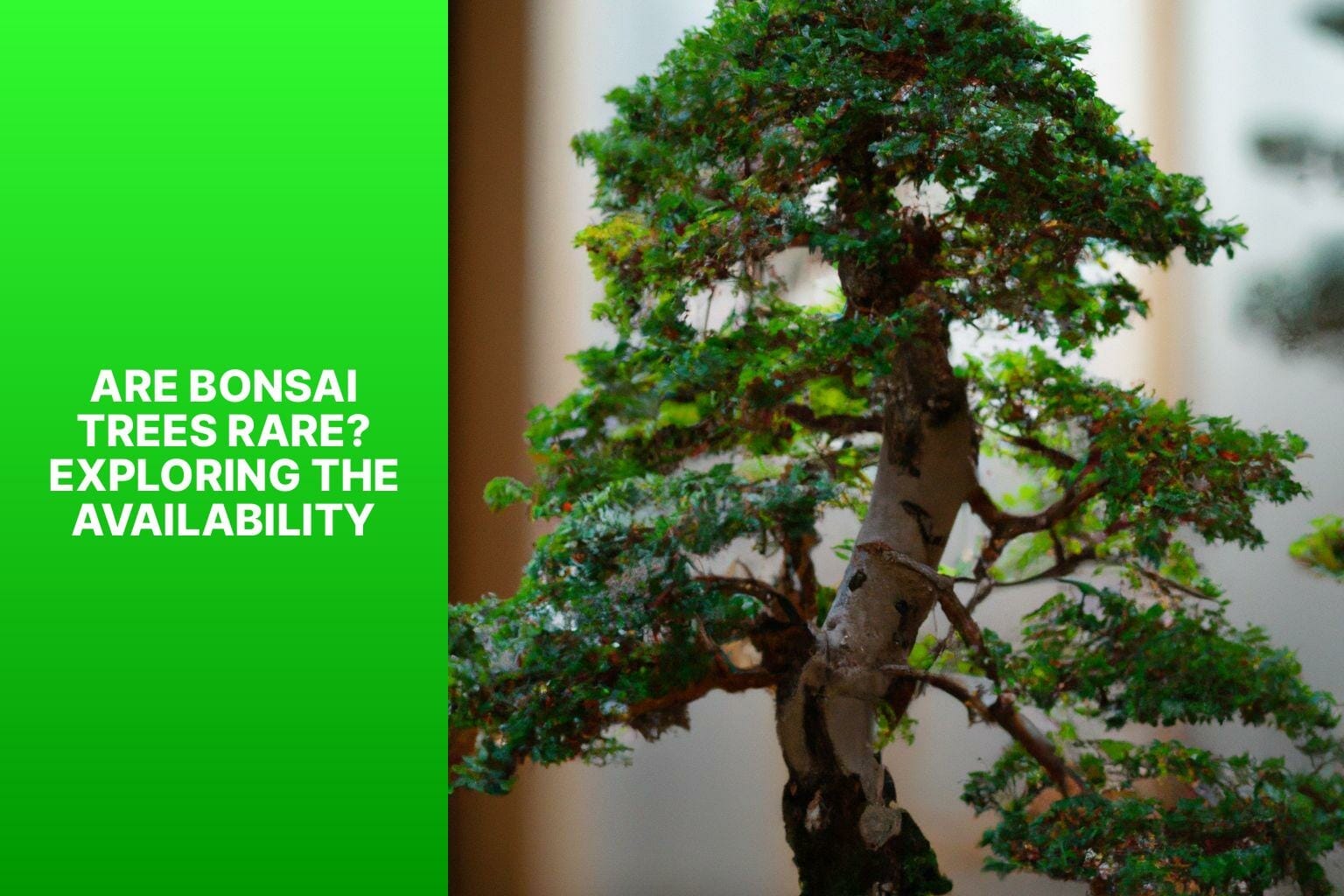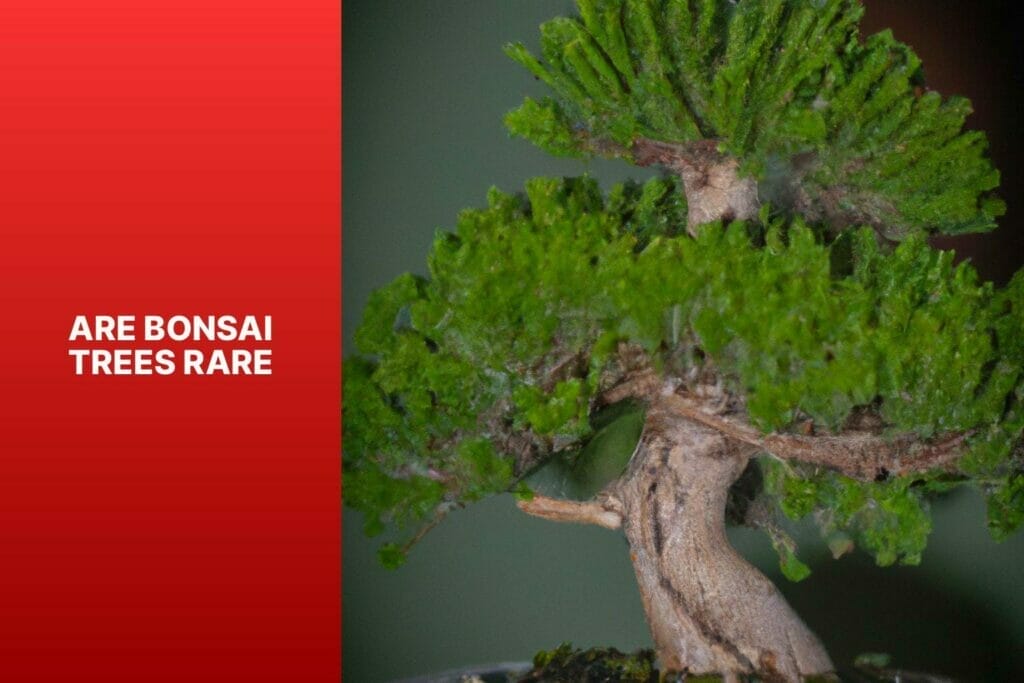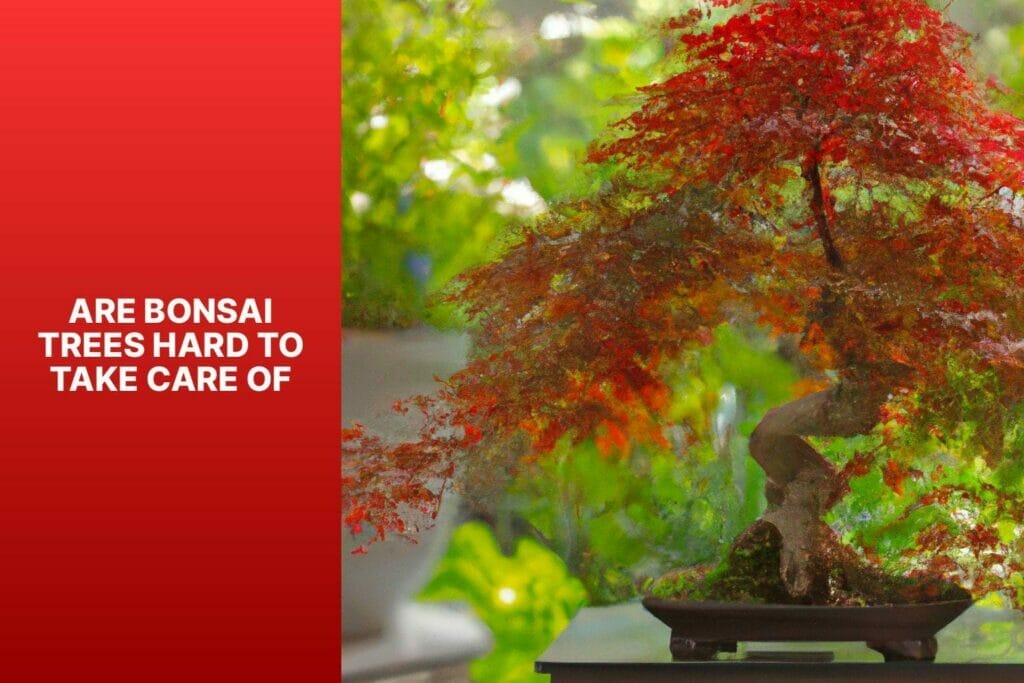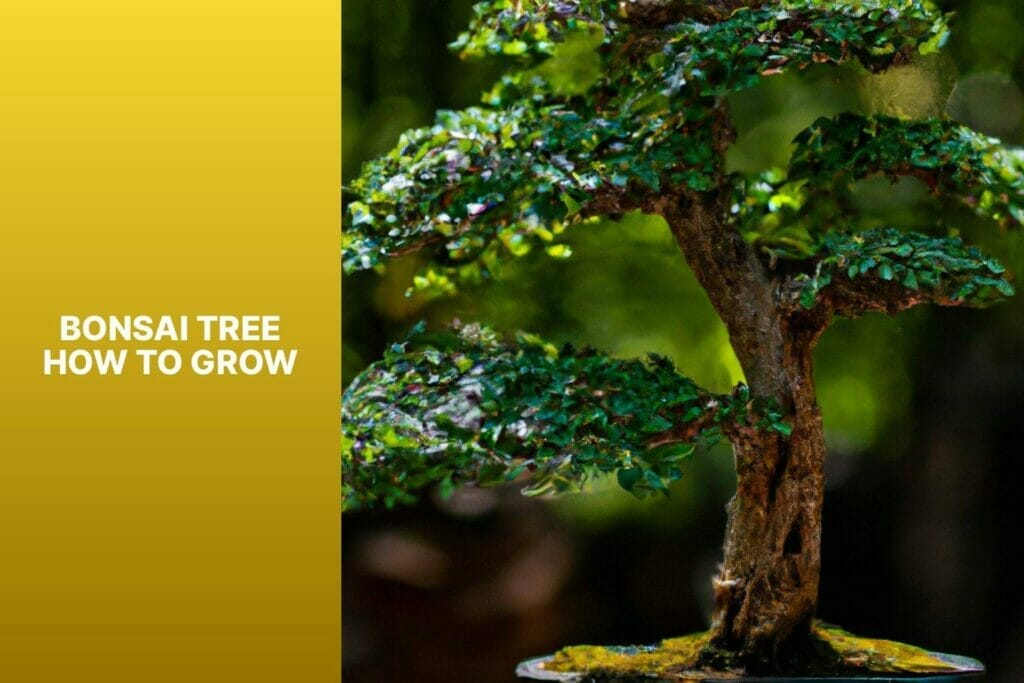Bonsai trees, with their miniature size and unique aesthetic appeal, have captivated the hearts of many nature enthusiasts and collectors.
An art form originating from ancient China and Japan, bonsai involves cultivating and shaping small trees to resemble fully-grown, mature trees in miniature form.
Regarding the rarity of bonsai trees, there are various factors to consider. In this article, we will delve into the world of bonsai trees and explore the concept of rarity within this art form.
Understanding the rarity of bonsai trees involves examining the factors that contribute to their uniqueness. These factors include the tree species, age, size, styling techniques, and the overall level of craftsmanship involved in their creation.
Each of these elements plays a role in determining the rarity and value of a bonsai tree.
Are bonsai trees rare? The answer is not straightforward. While certain varieties of bonsai trees may be more readily available due to their popularity and ease of cultivation, there are also rare and unique bonsai tree varieties that are highly sought-after by collectors.
Understanding the availability of bonsai trees involves exploring the common and popular varieties and the rare and unique ones.
Regarding bonsai tree cultivation, enthusiasts have a wide range of options. Popular and common bonsai tree varieties include the Juniper, Ficus, and Chinese Elm, widely available and suitable for beginners.
On the other hand, rare and unique bonsai tree varieties, such as the Japanese Maple, Wisteria, and Pine, are more challenging to cultivate and hence less common to find.
Determining the value of bonsai trees is a complex process that considers various factors such as the age, species, styling, and overall condition of the tree.
Rare and unique bonsai tree varieties with exceptional characteristics and high craftsmanship often command higher prices in the market.
Knowing where to find them is essential for collectors and enthusiasts interested in obtaining and caring for rare bonsai trees.
Specialized nurseries, bonsai exhibitions, and online marketplaces are some places where rare bonsai trees can be sourced.
Caring for rare bonsai trees requires meticulous attention to their needs, including watering, fertilizing, pruning, and providing suitable growing conditions.
Key takeaway:
- Bonsai trees can be rare: Certain factors contribute to the rarity of bonsai trees, making them unique and highly sought after by collectors.
- The availability of bonsai trees varies: While some varieties are popular and common, others are considered rare and unique, making them harder to find.
- Rare bonsai trees hold value and appreciation: The rarity of bonsai trees adds to their value and makes them highly appreciated by bonsai enthusiasts and collectors.
Understanding Rarity in Bonsai Trees
With the mesmerizing world of bonsai trees, rarity adds an enchanting allure. Delve into the realm of understanding the rarity of bonsai trees as we unravel the factors contributing to this coveted quality.
Explore the intricate details that make certain bonsai trees special, uncovering the intriguing blend of artistry and horticultural expertise that makes them stand out. Discover the allure of rarity and its unique allure in the bonsai world.
Factors that Contribute to Rarity
Factors contributing to the rarity of bonsai trees include age, size, species, and unique characteristics. Age is significant in determining rarity as older bonsai trees take longer to grow and cultivate, making them rarer.
Additionally, size affects rarity, with smaller or miniature bonsai trees being more desirable and rarer. The bonsai tree species also contributes to its rarity, as some species are more common while others are more unique and rare.
The rarer species are harder to find and cultivate, adding to their value. Unique characteristics such as unusual bark patterns, highly intricate or rare foliage, and exceptional artistic styling make a bonsai tree rare and highly sought after by collectors.
These factors contribute to the market’s rarity and value of bonsai trees. Due to their scarcity and unique features, collectors and enthusiasts are willing to pay higher prices for rare bonsai trees.
Therefore, it is crucial to consider these factors when determining the rarity and value of a bonsai tree, as they greatly impact its desirability and appreciation in the bonsai community.
Are Bonsai Trees Rare? Exploring the Availability

Photo Credits: Mnbonsainetwork.Com by Gerald Nelson
Are bonsai trees rare? Let’s dive into the availability of these captivating miniature trees. We’ll uncover the world of bonsai tree cultivation, explore popular and common varieties, and discover the realm of rare and unique bonsai tree specimens.
Get ready to unlock the secrets behind these fascinating botanical treasures.
Bonsai Trees and Their Cultivation
1. Bonsai trees require pruning and shaping techniques to cultivate miniature versions of trees.
2. Patience and attention are essential for cultivating bonsai trees to achieve the desired aesthetic and form.
3. Bonsai trees can be cultivated from various tree species, such as pine, Maple, juniper, and cherry blossom.
4. To ensure healthy bonsai growth, it is crucial to use proper soil mixtures and regularly water the trees.
5. Training wires are used to shape the branches and stems of the bonsai trees according to specific forms and designs.
6. Regular pruning is necessary to maintain the size and shape of bonsai trees and promote new growth.
7. For photosynthesis and leaf growth, bonsai trees require sufficient sunlight.
8. Appropriate fertilizers are crucial for providing essential nutrients for the health of bonsai trees.
9. Periodic repotting is necessary to ensure a healthy root system and overall growth of bonsai trees.
10. protecting bonsai trees from extreme temperatures and harsh weather conditions is important to prevent damage.
Beautiful and unique bonsai trees can be created and maintained by following these cultivation practices.
Popular and Common Bonsai Tree Varieties
Popular and common bonsai tree varieties include:
– Juniper (Juniperus chinensis): This is a popular and common bonsai tree variety with dense foliage that can tolerate different climates.
– Japanese Maple (Acer palmatum): Admired for its vibrant foliage ranging from deep red to bright green, it is a popular and common bonsai tree variety with a delicate and elegant appearance.
– Ficus (Ficus benjamina): A popular and common choice for bonsai enthusiasts, the Ficus tree is adaptable and versatile with glossy leaves and a strong aerial root system.
– Chinese Elm (Ulmus parvifolia): The Chinese Elm is a hardy and popular bonsai tree with attractive leaves and a natural-looking shape that adapts well to indoor and outdoor environments.
– Pine (Pinus spp.): Pine trees symbolize strength and longevity, and they are a popular and common bonsai tree variety with their unique needle-like foliage, giving them a majestic and timeless appearance.
– Serissa (Serissa foetida): Serissa is a small flowering bonsai tree loved for its beautiful white or pink blossoms and compact size, and it is a popular and common bonsai tree variety.
When choosing a bonsai tree, consider personal preferences, the level of maintenance you’re willing to undertake, and the environmental conditions in your area.
Each variety of bonsai tree, including the popular and common varieties, has specific instructions, so make sure you can provide the necessary care for your chosen bonsai tree.
Rare and Unique Bonsai Tree Varieties
- Kingsville Boxwood: This variety is known for its small, compact leaves and ability to withstand extreme weather conditions.
- Ginseng Ficus: This unique tree has thick, exposed roots that resemble ginseng. It is prized for its intricate root structure.
- Japanese Maple: The Japanese Maple bonsai tree is highly sought after for its vibrant, changing foliage colors.
- Black Pine: This rare variety is known for its strong, rugged appearance, twisted branches, and dark green needles.
- Trident Maple: The Trident Maple features three-lobed leaves and stunning autumn colors.
- Juniper Procumbens Nana: This petite, rare tree is known for its low-growing, trailing branches and needle-like foliage.
- Flowering Cherry: The Flowering Cherry bonsai tree has beautiful, delicate blooms.
- Japanese White Pine: This rare variety has long, slender needles and a graceful, evergreen appearance.
- Wisteria: The Wisteria bonsai tree is prized for its stunning cascading flowers in purple, pink, and white shades.
- Chinese Elm: Known for its resilience and adaptability, the Chinese Elm bonsai tree has finely textured foliage.
These rare and unique bonsai tree varieties allow collectors and enthusiasts to own and cultivate distinctive specimens with diverse characteristics.
Whether you prefer the Black Pine’s rugged elegance or the Flowering Cherry’s delicate beauty, exploring these rare bonsai tree varieties allows for a deeper appreciation of bonsai cultivation.
Remember that finding these unique varieties may require more effort and resources, but the result is an exceptional addition to your bonsai collection.
Determining the Value of Bonsai Trees
Determining the Value of Bonsai Trees
Several key factors must be considered to determine the value of bonsai trees accurately. These factors include age, species, size, health, and aesthetics, which greatly influence the worth of these unique trees.
In the table provided below, each factor is described in detail:
| Factor | Description |
|---|---|
| Age | Older trees hold more value due to their longevity and maturity. |
| Species | Rare and sought-after species are highly prized and have a greater value. |
| Size | The larger the tree, the more valuable it becomes. |
| Health | Trees that are well-maintained and in good health command higher prices. |
| Aesthetics | Trees with visually pleasing and well-balanced forms are highly valued in the bonsai community. |
It is important to note that the value of bonsai trees can vary significantly based on these factors. For instance, a 50-year-old Japanese Maple bonsai tree in excellent health, with an aesthetically pleasing form, holds more value than a younger, less healthy tree of the same species.
Fun fact: The most expensive bonsai tree ever sold was a 400-year-old white pine named “Shunkaen,” which fetched a staggering $1.3 million at an auction.
Obtaining and Caring for Rare Bonsai Trees
Are you looking to get your hands on those elusive, rare bonsai trees? Look no further! In this section, we dive into obtaining and caring for these highly sought-after gems.
We’ll uncover the best places to find rare bonsai trees and discover the critical care required to keep them thriving. So, if you’re ready to embark on a journey of botanical treasure hunting and learn the secrets of nurturing these delicate beauties, hold on tight!
Places to Find Rare Bonsai Trees
When it comes to finding rare bonsai trees, consider the following places:
– Nurseries: Visit specialty bonsai or garden centers specializing in rare and unique plant varieties. These places often have rare bonsai trees for sale.
– Online marketplaces: Check online platforms that connect bonsai enthusiasts and sellers, such as bonsai forums and marketplaces. These platforms offer a wide range of bonsai trees, including rare varieties that may not be easily found locally.
– Bonsai conventions and exhibitions: Attend bonsai conventions or exhibitions in your area or internationally. These events unite enthusiasts and experts worldwide, showcasing diverse bonsai trees, including rare specimens.
– Private collectors and bonsai clubs: Connect with experienced collectors or join local clubs. Often, collectors are willing to sell or trade rare bonsai trees within their networks. Bonsai clubs also provide valuable resources for information and connections to find rare specimens.
Remember that the availability of rare bonsai trees can vary depending on the region and time of year. Researching and planning are important to increase your chances of finding the specific rare bonsai tree you desire.
Critical Care for Rare Bonsai Trees
Edited
Critical Care for Rare Bonsai Trees
Caring for rare bonsai trees requires attention and knowledge to ensure their health and longevity. Here are essential practices for critical care:
1. Watering: Proper watering is crucial for rare bonsai trees. Maintaining a balance, neither overwatering nor underwatering, is essential. Monitor soil moisture regularly and water accordingly to keep it consistently moist but not saturated.
2. Light and Temperature: Provide the bonsai tree with appropriate sunlight. Different species have varying light requirements, so understand the specific needs of your rare bonsai tree. Also, maintain stable temperatures suitable for optimal growth and avoid extreme temperature fluctuations.
3. Pruning and Trimming: Regular pruning and trimming maintain the bonsai tree’s desired size, shape, and health. Remove dead, damaged, or overgrown branches and foliage to promote healthy growth and maintain aesthetic appeal.
4. Fertilization: Apply balanced fertilizer during the growing season to provide nutrients for rare bonsai tree growth. Follow recommended dosage and frequency, as excessive fertilization can harm the tree.
5. Soil and Repotting: Use well-draining soil designed for bonsai trees to maintain proper moisture levels and prevent root rot. Repot the bonsai tree every 2-3 years, refreshing the soil and allowing for root development.
6. Pest and Disease Control: Regularly monitor the bonsai tree for signs of pests or diseases. Take immediate action if infestations or abnormalities are noticed, using appropriate pest control methods or seeking professional assistance.
Critical care for rare bonsai trees through proper watering, light exposure, pruning, fertilization, soil maintenance, and pest control ensures healthy growth and longevity.
Some Facts About Bonsai Trees Rarity:
- ✅ Bonsai trees are considered rare due to the intricate and time-consuming process of their cultivation. (Source: www.bonsaiempire.com)
- ✅ certain species of trees are more challenging to be trained as bonsai trees. (Source: www.bonsaisanctum.com)
- ✅ Giant Sequoia bonsai trees aid in preserving endangered species and provide opportunities for close observation. (Source: www.bonsaisanctum.com)
- ✅ Bonsai trees can be cultivated from various tree species, allowing for variety and uniqueness. (Source: www.rarest.org)
- ✅ Experienced masters have grown some of the most expensive bonsai trees, showcasing their expertise and artistry. (Source: www.rarest.org)


